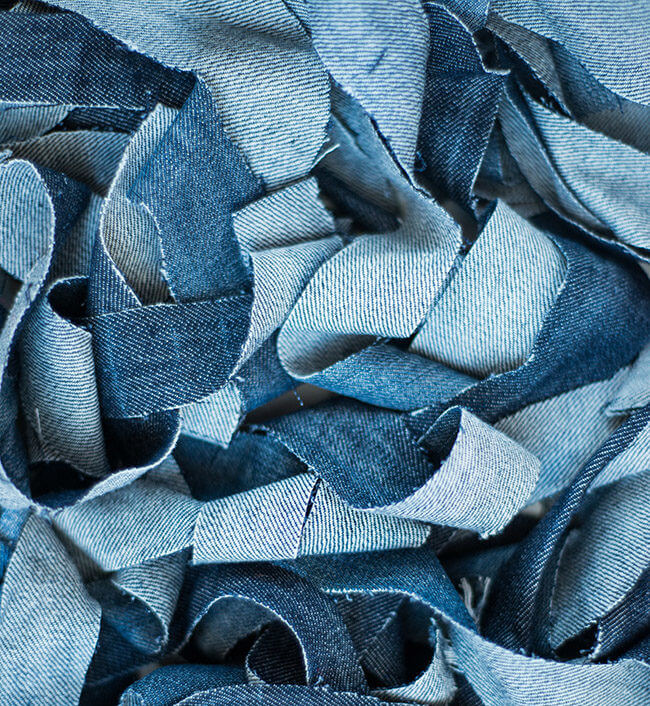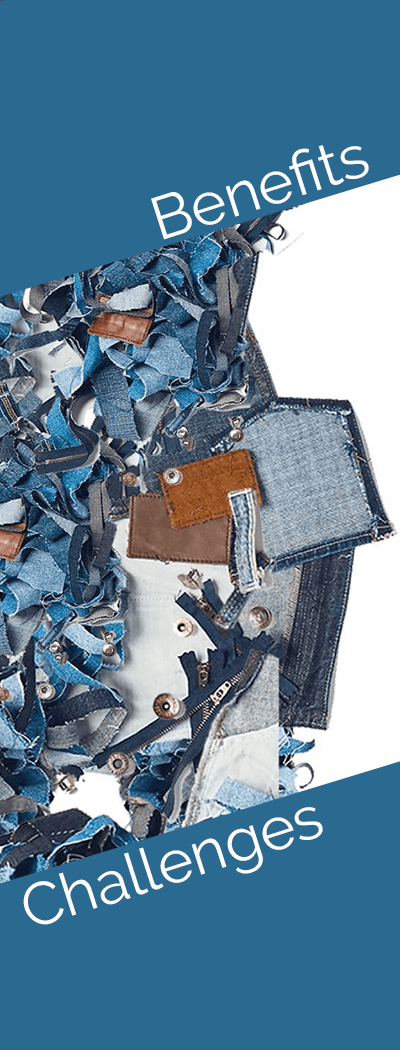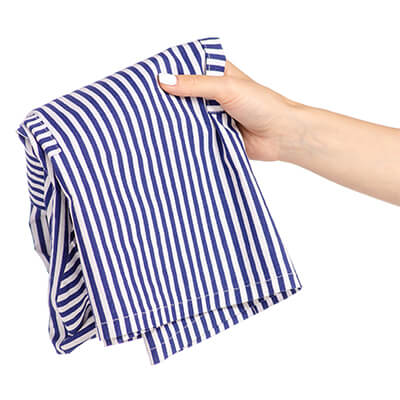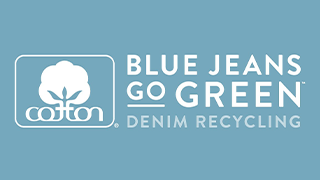Recycled Cotton
Sustainability & Recycled Cotton
Sustainability continues to be at the forefront of product decisions, brand initiatives, and strategic planning in the textile industry. The use of recycled materials, including recycled cotton, is a growing topic of interest in sustainability and sustainable textiles.
Recycled cotton is not a new concept to the textile and apparel market, but as manufacturers, brands, and retailers continue to evaluate their supply chain footprint, the interest in recycled cotton has grown.
What is Recycled Cotton?
Recycled cotton can be generally defined as converting cotton fabric into cotton fiber that can be reused in textile products. Recycled cotton is also commonly referred to as regenerated cotton, reclaimed cotton, or shoddy. Recycled content includes recycled raw material, as well as used, reconditioned, and re-manufactured components.
Textile recycling is generated from two primary sources:
- Pre-consumer: includes scraps created by yarn and fabric by-products
- Post-consumer: includes garments, upholstery, towels, household items to be repurposed
The largest volume of recycled cotton sources is produced through pre-consumer waste, such as cutting scraps. Post-consumer waste is more difficult to sort through due to various color shades, fabric blends, and it is generally a more labor-intensive process.

Process to Turn Fabric Back into Fiber
The majority of recycled cotton is claimed through mechanical recycling. First, fabrics and materials are sorted by color. After sorting, the fabrics are run through a machine that shreds the fabric into yarn and further into raw fiber. This process is harsh and puts a great deal of strain on the fiber. It is not uncommon for fibers to break and entangle during shredding. The raw fiber is then spun back into yarns for reuse in other products. The quality of recycled fiber will never have quality values equal to the original fiber. Specifically, fiber length and length uniformity will be impacted, which will limit the end-use application.
Benefits & Challenges to Recycled Cotton Fiber
Benefits
- As a sustainable fabric, cotton can find new life in many different low-grade products such as insulation, mop heads, rags, and stuffing.
- The process of recycling can divert many products from landfills. According to the Council for Textile Recycling, annual textile waste is estimated to equal 25 billion pounds.1
- The amount of energy, water, and dye use is reduced from using a product that has already been processed. The savings are achieved by offsetting the production of new materials. Since recycled cotton yarns most commonly are sourced from pre-consumer textile scraps that are sorted by color, the yarns are already dyed.
- The CO2 and fossil fuel emission savings can be partially offset by using existing materials. However, the collection, processing, and shipping of cotton scraps or clothing can reduce or neutralize some of these savings.2
Challenges
- Cotton must be blended with other fibers to be made into new yarn for strength and durability, and therefore cannot continuously be recycled.
- The content of recycled cotton will depend on the end-use application. Any amount of recycled product will impact the yarn and fabric properties such as evenness, strength, and uniformity.
- Recycled yarn cost is generally higher than standard, virgin cotton yarn costs, and could possibly be cost-prohibitive.
- Testing instruments are made for ginned, virgin cotton. Sometimes, testing results can be skewed due to the difference in fiber packing and orientation.
- The risk of contamination by other fibers is much higher for recycled cotton. Stitching, sewing thread, small amounts of spandex should all be taken into account when establishing the recycled supply chain.

Consumer Interest
Cotton Incorporated’s Lifestyle Monitor™ research shows that consumers are seeking out recycled materials, but “recycled” does not necessarily equate to “sustainable” in a consumers’ mind.1 Research shows that 24% of consumers are willing to pay more for clothing or home textiles that are labeled as “recycled” and 32% of consumers who plan on purchasing clothing or home textiles will look for “recycled” clothing. However, only 5% of consumers believe that “sustainable” equals “recycled.” Consumers place more value in clothing or products labeled as “100% cotton,” “natural,” or “environmentally-friendly.”
24%
of consumers are willing to pay more for clothing or home textiles that are labeled as “recycled”
32%
of consumers who plan on purchasing clothing or home textiles will look for “recycled” clothing
Only 5%
of consumers believe sustainable = recycled
Recycling Efforts
Today, there are many recycling efforts by well-known brands that have launched initiatives within their stores. Companies such as Columbia, The North Face, Patagonia, and many others encourage consumers to bring in old clothing to be repurposed. Most companies that encourage consumers to recycle their clothing allow clothes from any brand to be dropped off. Some of these initiatives include consumer benefits such as coupons or points towards future purchases. Patagonia also focuses on repairing old clothing to extend the life of the product.
Cotton Incorporated has created a denim recycling program called Blue Jeans Go Green™. The Blue Jeans Go Green™ initiative recycles old denim jeans to be preprocessed and converted into insulation. The program, created in 2006, has collected over three million pieces of denim and diverted over 1,700 tons of textile waste from landfills.
Use Natural Fibers—Like Cotton
As the conversation around sustainability continues to move toward a greater need for improving the life of garments rather than promoting a disposable business model, companies should consider using virgin cotton and promoting its sustainable, natural benefits. Recycled cotton is a great option for reducing textile waste and repurposing for lower grade products, but there are still challenges to overcome for end-uses, especially in the apparel market.
Recycled cotton has its place for certain end-uses, but the challenges with strength and quality reduction can cause issues during production and after the consumer takes the product home. Once garments are recycled, they cannot continue to be recycled due to the fiber separation process that weakens the fibers—recycled materials cannot be recycled infinitely.

Ultimately, virgin cotton is already a sustainable option. Cotton is a natural and biodegradable fiber. Companies should be encouraged to tell their sustainability stories with virgin cotton, rather than creating low-quality garments from recycled cotton.4
Learn more about cotton’s footprint, LCA, and traceability.
Recycling Textiles: Exploring the Possibilities of Recycled Cotton
With increasing consumer focus on sustainability and circularity, recycled textiles are seen by many as a key driver toward more sustainable apparel. Due to its natural fiber properties, cotton has a unique opportunity in the sector of recycled apparel.
Karla Magruder, founder of Accelerating Circularity, discusses how this organization works to identify obstacles in the broader adoption of recycled apparel and devise solutions that will create a process to scale up the recycling of textile materials.
Martin Schreiner, director of fiber processing at Cotton Incorporated, explores the opportunities and challenges of integrating recycled cotton into nonwovens and textiles.
Originally played 4/19/22
Recycled Cotton Suppliers
If you are a recycled cotton supplier and would like to be added to this list, contact us at cottonworks@cottoninc.com.
Blue Jeans Go Green™ Program
The Blue Jeans Go Green™ program collects denim (made from cotton) so that it can be recycled back to its original fiber state and transformed into something new.
1 Council for Textile Recycling (2018). http://www.weardonaterecycle.org.
2 Recycled Cotton. (2014). Textile Exchange.
3 Cotton Incorporated’s Lifestyle Monitor™ Survey
4 Li, Lili; Frey, Margaret; Browning, Kristie. Biodegradability Study on Cotton and Polyester Fabrics. Cornell University, October 2008 -September 2009.


